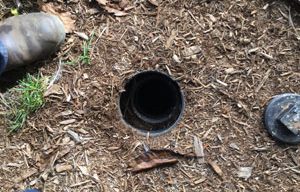
Not that long ago a sewer pipe repair meant, at the least, a large hole to dig down and replace a section of the line. At worst, digging a trench from your home out to the street for a complete sewer pipe replacement. But today’s trenchless pipe lining technology means only one or two small access holes, and sometimes no digging at all. Basically, it creates a new cured-in-place pipe (CIPP) inside the existing damaged line. That’s far less disruptive, and can be the lowest-cost option if restoring pavement and landscaping are necessary.
Epoxy pipe lining can be used for hot and cold water supply lines, sprinkler systems, and HVAC plumbing. But since getting access to those pipes is comparatively inexpensive pipe relining is most commonly used for underground and under-foundation drain and sewer pipes. The new inner pipe is a long-term solution — it increases the life span of plumbing by a decade or more.
Better than New?
So it’s now possible to restore a leaking pipe from the inside, creating an essentially new pipe, with no damage to pavement, landscaping, floors, or walls. The CIPP pipe is seamless and 100% waterproof, offering several benefits over most original sewer line materials.
- There are no joints to separate and leak.
- It doesn’t corrode.
- It’s resistant to tree roots.
- There’s no build-up of calcium deposits.
- It resists minor soil settling and minor seismic events.
It is true that if you’re willing to put up with the delays and disruption of trenching, traditional repairs and replacements can be roughly 25% less expensive. But if the cost of restoring pavement, relocating utilities, and re-establishing landscaping are added in it can save many thousands of dollars.
Trenchless Pipe Lining Process
Fortunately, pipe lining repairs and rehabilitation are suitable for the types of sewer pipes that commonly need replacing. That includes cast iron pipe, clay tile, and asbestos cement.
Our pipe lining services typically take one day or less. And it can start almost immediately without waiting days to arrange trenching, concrete demolition, and so on.
- We start with an in-pipe video inspection to assess the condition of the line and anticipate any issues.
- We hydro-jet the line to completely remove debris, build-up, mineral scale, and roots to assure a successful CIPP pipe, well-adhered to the existing line.
- We saturate a seamless felt liner with a special 2-part epoxy.
- The liner together with a rubber “bladder” is pulled through the pipe.
- Inflating the bladder presses the epoxy pipe lining against the old pipe.
- The epoxy cures (hardens) in a few hours.
- We deflate and remove the bladder.
- We perform another camera inspection and test for leaks.
We’ll be happy to show you before and after pictures of the inside of the line.
Concerns Answered
This technology isn’t suitable in all situations, and may or may not be the most economical solution. For example, there may be too many sharp bends in the sections of the line that need replacing. We’ll be happy to discuss the pros and cons of your particular situation and answer all your questions. Here are some concerns we’re often asked about.
- How long does it last? We won’t recommend it unless we’re confident it will significantly increase the lifetime of the line. Durable pipes can be expected to last 30 to 40 years. A relined pipe has a life expectancy of around 50 years. Epoxy warranties often range from 5 to 10 years, others extend to 35 years. But everything has to be done right for proper curing and adhesion.
- Is it strong? The epoxy coating does more than seal pinholes and leaks. It adds structural strength for an end result that’s stronger than PVC pipe and stronger than cast iron.
- Doesn’t it reduce the diameter and restrict flow? That’s one of the things we’re careful about. For home sewer pipes the lining is less than a tenth of an inch thick. The result is smoother than the old pipe. With no corrosion or scale build-up, on balance, the flow rate typically increases rather than decreases.
- Do I have do replace the whole line? In some cases, we may line only a 2 to 5-foot section, but it’s usually best to rehabilitate the whole line to guard against future problems.
For Trenchless Pipe Lining Call ASAP Drain Guys & Plumbing
We’re A+ BBB rated and have been serving San Diego since 2001. Learn more or contact us any time.

